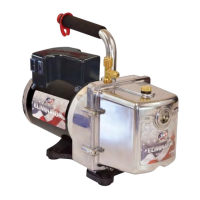5
JB INDUSTRIES • ELIMINATOR OPERATING MANUAL • 800.323.0811 • SALES@JBIND.COM • JBIND.COM
Now, fill the pump to the proper oil level and allow the pump to run with the
isolation valve closed for 3 or 4 minutes to warm up the oil. Check all o-ring caps
for dirt and proper seal. Connect a vacuum gauge (JB recommends the DV-22N,
DV-41 or DV-40S) directly to the 1/4" port on the intake tee (Figure 8). Do not
use a charging line. Open the isolation valve.
DO NOT
USE A CHARGING LINE
A charging line, especially a new line, will give you a higher
micron reading because you are reading the environment
inside the hose (Figure 11).
Figures 11 and 12 are the same, but (Figure 10) is a direct connection hook-up
and (Figure 11)
is a connection through a new charging line. Both hook-ups are
allowed to run the same length of time, but (Figure 10) is at 20 microns while
(Figure 11)
is at 297. If left on, the charging line hook-up will come down in its
micron reading, but it will take a much greater period of time. If the hose is cleaned
out with alcohol and vacuumed for a long period of time, the micron reading will
go lower.
USING CHARGING AND TESTING
HOSES FOR EVACUATION
If a leak is suspected: An evacuation/dehydration hook-up requires a leak-proof
design in all of the components. Only soft copper tubing, pure rubber hoses, or
flexible metal hoses are absolutely vacuum tight. Charging hoses are designed for
positive pressure. Even with the advanced technology of today’s hoses, permeation
through the hose compound still exists (Figure 12).
If you have blanked-off your pump to check pressure rise and your hoses and
connections are not leak-free, the atmosphere will permeate to the lower pressure
in the hoses. Your reading will slowly rise and you will spend time looking for
system leaks.
PUMP CONNECTIONS
Moving to the connections on the pump, the factory intake is loctited into place
and each pump is tested for leaks. If this is not disturbed, the chances of a leak are
virtually non-existent. Any leak would come from the connection at the port being
used and to the connection to the system.
One of the most common errors with both the o-ring and the gasket couplers is
the wrenching down of these couplers with a pair of pliers or channel locks
(Figure 13)
. Please refer to our Principles of Deep Vacuum article. This article
can be found at www.jbind.com under Product Support.
DO NOT
Wrench down on coupler (Figure 13).
The article, Principles of Deep Vacuum, shows there is a need for sealing with a
vacuum tight o-ring (Figure 14)
. Gaskets, like those used in charging lines, are
made for pressure. What wrenching of the coupler does is to smash the brass cup
that holds the gasket or o-ring against the male flare fitting. This causes the brass
cup to expand outward against the threads of the coupler and makes it tight to turn.
This causes the o-ring to fall out of the cup that is holding the o-ring or gasket
in place.
Another error seen is that technicians have a brass adapter fitting on the intake of
the pump with no copper gasket. The first time you wrench the adapter into place,
it might seal. But, as soon as you break the seal and re-tighten, there is a chance
for a leak. The best hook-up that guarantees there are no leaks in the system is by
using JB’s valve core removal tools (Figure 15).
Figure 10
Figure 11
Figure 12
CHARGING SYSTEM
Gas under pressure in the
hose will permeate to the lower
pressure of the atmosphere.
EVACUATION
The atmosphere which has a
higher pressure permeates to
the lower pressure in the hose.
Figure 13 Figure 14
Figure 15
Flare
Fitting
Specially
Designed Groove
Locks O-Ring
In Place
45° Positiv
Stop
DEEP VACUUM
O-RING COUPLER CUT-AWAY

